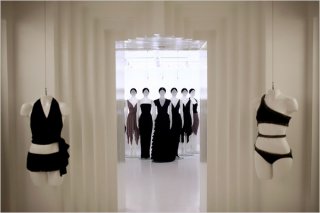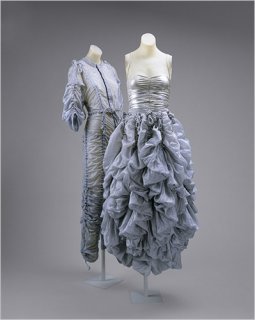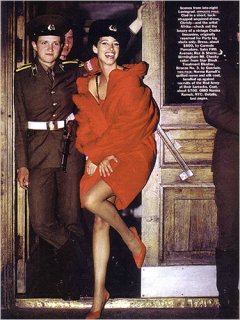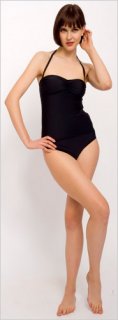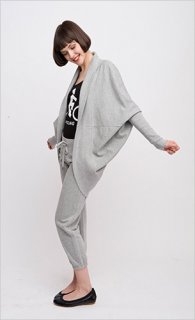Always in Her Element
By RUTH LA FERLA
LEGENDS die hard around Norma Kamali. In the fantasies of longtime fans, she is a 1970s-era disco siren, stalking into Studio 54 on dagger heels. Others imagine a vixen with darkly fetishistic leanings. Myths have sprung up, too, around Ms. Kamali’s designs, especially her puffer coat, made, it was reported, from the sleeping bag she curled up in at night after her divorce.
Embellished over time, such stories make her smile. But over tea last week near her shop on West 56th Street, Ms. Kamali was prepared to set the record straight. Her disco days are decades behind her, she said. And, despite an archive that includes studded skirts and bondage-wrapped playwear, she does not harbor a fondness for latex and lace.
As for that fabled sleeping-bag coat: After splitting with her husband, Mohammed (Eddie) Kamali, in the mid-1970s, she took to camping in the woods with a boyfriend. “It was cold,” she recalled, “and I was always getting up at night to go to the bathroom.” On one particularly nippy night, she threw on her sleeping bag and sprinted for the bush. “As I was running,” she said, “I was thinking, ‘I need to put sleeves in this thing.’ ”
The rest is rag-trade history. Variations of that seminal Kamali design have inspired generations of puffy down coats. An emblem of urban survivalist chic, the original spiked in popularity after 9/11. “When it really looked like slim pickings for selling anything, we were making sleeping-bag coats out of every piece of fabric we had,” Ms. Kamali recalled. “That coat is what kept us in business.”
Even now, it appears to be recession-proof. Much like Ms. Kamali herself. An enduring presence in an industry that has brusquely disposed of many of her peers, she has hung onto her business and to OMO (On My Own), her gallerylike Manhattan flagship, through more than three decades and several economic downturns. Fashion’s current infatuation with the 1980s has sparked a run on her vintage designs. And her updated spin on Grecian draped jerseys and sexy fleece activewear, priced to sell at every level of the marketplace — including Wal-Mart, of all places — have made Ms. Kamali a go-to designer for lean times.
At 63, she remains “one of those perennial American favorites, with both the general shopper looking for style at a great price and the hardcore fashionista who wants that special something,” said Constance White, the style director of eBay, where vintage Kamali pieces are steadily sought after.
The auction site could double as a catalog of Ms. Kamali’s pioneering concepts. They include cocoon-wrap fleece coats, backless jersey jumpsuits and a ruched one-shoulder dress. More unexpected is a little black shirtdress made of stretch jersey, which sold for $39, nearly double its original price at Wal-Mart, where Ms. Kamali’s designs made their debut 15 months ago, showcased in more than 400 stores under the NK for Wal-Mart label.
Her innovations include a string of minifilms taped in the early 1980s, precursors to contemporary fashion videos. Around that time she dispensed with major runway shows. (“They seemed so old-fashioned to me,” she said.) As far back as 1996, she introduced a company Web site. And in 2005, well before such partnerships became an industry commonplace, she teamed with Everlast and Spiegel to sell modestly priced capsule collections. But of all her endeavors, Ms. Kamali’s collaboration with Wal-Mart is perhaps the most audacious.
First, she has seen fit to work with a discounting behemoth that has fared disastrously with fashion in the past. A dreary Mark Eisen collection in 2006 failed ignominiously.
Ms. Kamali has also bet — correctly, to judge by her Wal-Mart best sellers — that admirers of her batwing fleece jackets, pinup-worthy swimsuits and shape-shifting jersey tunics will buy modified versions of those cutting-edge styles from a merchant of pork chops and pans.
Wal-Mart declined to provide sales figures but said that the sporty looks were the top sellers in the NK line, which is licensed through the Cherokee apparel group. A swimsuit collection will appear in mid-June.
Perhaps most significantly, Ms. Kamali is offering career-wear and activewear for $20 or less, prices that steeply undercut comparable items by Vera Wang for Kohl’s or Matthew Williamson for H&M. Her decision to partner with Wal-Mart “is radical, but not too surprising” said David Wolfe, the creative director of the Doneger Group, which forecasts fashion and retail trends. “Her thinking has always been out of the box, even at times outrageously subversive.”
Ms. Kamali insists she is not hiding a defiant streak. “I’m pretty transparent,” she said. “What you see is what there is.”
What you see, peering at her closely for signs of wear, is a sultry hybrid of Vargas vamp and comely vestal priestess draped in a one-shoulder tunic of her own design. Her milky skin and toned physique are, she indicated, the products of unyielding discipline — that and lots of green tea, rigorous workouts at the gym and weekly tai chi sessions with her staff in Central Park.
When she talks about her beauty secrets, Ms. Kamali exudes a girl-to-girl warmth that belies an impatience and flinty tenacity. She never has had much use, she said, for the orthodoxies of her trade. “The idea of branding, we have to rethink that,” she said. “Sometimes a label only gets in the way.”
As a way to feel out the marketplace, she offers a small selection of Kamali designs, cherry-picked by her staff — and minus a label — to a handful of indie boutiques.
She also tests the market by selling Kamali designs at private parties across the country. Participants selling more than $10,000 worth of merchandise get half back, Ms. Kamali said. “It’s as if you were a wholesale account.” And, for the designer, part of a growing grass-roots sales force.
At times her maverick streak has raised hackles in the industry. After a much publicized imbroglio with the International Ladies Garment Workers Union, in 1987, Ms. Kamali was fined $10,000 by the state Labor Department for illegally employing workers to cut and sew for her at home. She paid the fine, then shut down her wholesale operation; and, in a move that further inflamed union sentiments, moved a portion of her manufacturing to Italy.
Two years ago, in a dispute over pricing (Ms. Kamali wanted to go cheaper), she severed ties with Everlast. As a retailer once anonymously remarked, “She’s a tiger when it comes to doing business.”
Ms. Kamali, who says she has never had a business partner or investor, and will not disclose her earnings, is the first to acknowledge that she can be fearsomely uncompromising. “I struggle with fit,” she said of working with the suppliers of her Wal-Mart line. “I thought those people were, like, going to put a hit out on me because I was so relentless.”
Early in her career, which began to thrive in 1974, when she started selling her designs at her upstairs shop on Madison Avenue, Ms. Kamali, a native of Manhattan, made her name as a fashion world MacGyver. A nimble thinker, she improvised many of her looks from commonplace materials: jumpsuits snipped from parachute silk, with rip cords intact; evening dresses reminiscent of Hollywood’s Golden Age made from gold lamé curtains; a kimono fashioned from an Appalachian quilt; and bloomers, ballet skirts and tunics cut from lowly sweatshirt fabric.
Snobbery is as alien to Ms. Kamali as the little bourgeois sheaths and matching handbags that, even in the ’60s, she never could bring herself to wear.
“She’s never been depressed by working with inexpensive fabrics,” said Caroline Rennolds Milbank, a fashion historian. “She’s put as much design effort into something made with sweatshirt material as she has with matte jersey.”
That 1980 fleece collection, which introduced the notion of activewear as everyday clothing, was itself the product of an economic downturn, Ms. Kamali recalled. “It came out of people needing to have something that was affordable but fun.”
Working with Wal-Mart takes her back to her improvisational roots. Her designs for the chain are tweaked, streamlined versions of the styles she sells through OMO and Bergdorf Goodman, which carries Kamali swimsuits. She confines the plunging necklines, effusive draping and geometric cutouts that define her high-end looks mostly to her New York shop.
But, she said: “I haven’t compromised anything. If I think of something as lesser, it’s insulting to the consumer.” Even some of the fabrics, she added, are like those of her signature label.
When the NK line was unveiled last year at Wal-Mart in Westbury, N.Y., customers rushed past store clerks and models in skyscraper platforms to greet the designer.
“I cried,” Ms. Kamali recalled. “People were asking me to sign their receipts — $30 sales slips. It was cool.”
story and images from nytimes.com
By RUTH LA FERLA
LEGENDS die hard around Norma Kamali. In the fantasies of longtime fans, she is a 1970s-era disco siren, stalking into Studio 54 on dagger heels. Others imagine a vixen with darkly fetishistic leanings. Myths have sprung up, too, around Ms. Kamali’s designs, especially her puffer coat, made, it was reported, from the sleeping bag she curled up in at night after her divorce.
Embellished over time, such stories make her smile. But over tea last week near her shop on West 56th Street, Ms. Kamali was prepared to set the record straight. Her disco days are decades behind her, she said. And, despite an archive that includes studded skirts and bondage-wrapped playwear, she does not harbor a fondness for latex and lace.
As for that fabled sleeping-bag coat: After splitting with her husband, Mohammed (Eddie) Kamali, in the mid-1970s, she took to camping in the woods with a boyfriend. “It was cold,” she recalled, “and I was always getting up at night to go to the bathroom.” On one particularly nippy night, she threw on her sleeping bag and sprinted for the bush. “As I was running,” she said, “I was thinking, ‘I need to put sleeves in this thing.’ ”
The rest is rag-trade history. Variations of that seminal Kamali design have inspired generations of puffy down coats. An emblem of urban survivalist chic, the original spiked in popularity after 9/11. “When it really looked like slim pickings for selling anything, we were making sleeping-bag coats out of every piece of fabric we had,” Ms. Kamali recalled. “That coat is what kept us in business.”
Even now, it appears to be recession-proof. Much like Ms. Kamali herself. An enduring presence in an industry that has brusquely disposed of many of her peers, she has hung onto her business and to OMO (On My Own), her gallerylike Manhattan flagship, through more than three decades and several economic downturns. Fashion’s current infatuation with the 1980s has sparked a run on her vintage designs. And her updated spin on Grecian draped jerseys and sexy fleece activewear, priced to sell at every level of the marketplace — including Wal-Mart, of all places — have made Ms. Kamali a go-to designer for lean times.
At 63, she remains “one of those perennial American favorites, with both the general shopper looking for style at a great price and the hardcore fashionista who wants that special something,” said Constance White, the style director of eBay, where vintage Kamali pieces are steadily sought after.
The auction site could double as a catalog of Ms. Kamali’s pioneering concepts. They include cocoon-wrap fleece coats, backless jersey jumpsuits and a ruched one-shoulder dress. More unexpected is a little black shirtdress made of stretch jersey, which sold for $39, nearly double its original price at Wal-Mart, where Ms. Kamali’s designs made their debut 15 months ago, showcased in more than 400 stores under the NK for Wal-Mart label.
Her innovations include a string of minifilms taped in the early 1980s, precursors to contemporary fashion videos. Around that time she dispensed with major runway shows. (“They seemed so old-fashioned to me,” she said.) As far back as 1996, she introduced a company Web site. And in 2005, well before such partnerships became an industry commonplace, she teamed with Everlast and Spiegel to sell modestly priced capsule collections. But of all her endeavors, Ms. Kamali’s collaboration with Wal-Mart is perhaps the most audacious.
First, she has seen fit to work with a discounting behemoth that has fared disastrously with fashion in the past. A dreary Mark Eisen collection in 2006 failed ignominiously.
Ms. Kamali has also bet — correctly, to judge by her Wal-Mart best sellers — that admirers of her batwing fleece jackets, pinup-worthy swimsuits and shape-shifting jersey tunics will buy modified versions of those cutting-edge styles from a merchant of pork chops and pans.
Wal-Mart declined to provide sales figures but said that the sporty looks were the top sellers in the NK line, which is licensed through the Cherokee apparel group. A swimsuit collection will appear in mid-June.
Perhaps most significantly, Ms. Kamali is offering career-wear and activewear for $20 or less, prices that steeply undercut comparable items by Vera Wang for Kohl’s or Matthew Williamson for H&M. Her decision to partner with Wal-Mart “is radical, but not too surprising” said David Wolfe, the creative director of the Doneger Group, which forecasts fashion and retail trends. “Her thinking has always been out of the box, even at times outrageously subversive.”
Ms. Kamali insists she is not hiding a defiant streak. “I’m pretty transparent,” she said. “What you see is what there is.”
What you see, peering at her closely for signs of wear, is a sultry hybrid of Vargas vamp and comely vestal priestess draped in a one-shoulder tunic of her own design. Her milky skin and toned physique are, she indicated, the products of unyielding discipline — that and lots of green tea, rigorous workouts at the gym and weekly tai chi sessions with her staff in Central Park.
When she talks about her beauty secrets, Ms. Kamali exudes a girl-to-girl warmth that belies an impatience and flinty tenacity. She never has had much use, she said, for the orthodoxies of her trade. “The idea of branding, we have to rethink that,” she said. “Sometimes a label only gets in the way.”
As a way to feel out the marketplace, she offers a small selection of Kamali designs, cherry-picked by her staff — and minus a label — to a handful of indie boutiques.
She also tests the market by selling Kamali designs at private parties across the country. Participants selling more than $10,000 worth of merchandise get half back, Ms. Kamali said. “It’s as if you were a wholesale account.” And, for the designer, part of a growing grass-roots sales force.
At times her maverick streak has raised hackles in the industry. After a much publicized imbroglio with the International Ladies Garment Workers Union, in 1987, Ms. Kamali was fined $10,000 by the state Labor Department for illegally employing workers to cut and sew for her at home. She paid the fine, then shut down her wholesale operation; and, in a move that further inflamed union sentiments, moved a portion of her manufacturing to Italy.
Two years ago, in a dispute over pricing (Ms. Kamali wanted to go cheaper), she severed ties with Everlast. As a retailer once anonymously remarked, “She’s a tiger when it comes to doing business.”
Ms. Kamali, who says she has never had a business partner or investor, and will not disclose her earnings, is the first to acknowledge that she can be fearsomely uncompromising. “I struggle with fit,” she said of working with the suppliers of her Wal-Mart line. “I thought those people were, like, going to put a hit out on me because I was so relentless.”
Early in her career, which began to thrive in 1974, when she started selling her designs at her upstairs shop on Madison Avenue, Ms. Kamali, a native of Manhattan, made her name as a fashion world MacGyver. A nimble thinker, she improvised many of her looks from commonplace materials: jumpsuits snipped from parachute silk, with rip cords intact; evening dresses reminiscent of Hollywood’s Golden Age made from gold lamé curtains; a kimono fashioned from an Appalachian quilt; and bloomers, ballet skirts and tunics cut from lowly sweatshirt fabric.
Snobbery is as alien to Ms. Kamali as the little bourgeois sheaths and matching handbags that, even in the ’60s, she never could bring herself to wear.
“She’s never been depressed by working with inexpensive fabrics,” said Caroline Rennolds Milbank, a fashion historian. “She’s put as much design effort into something made with sweatshirt material as she has with matte jersey.”
That 1980 fleece collection, which introduced the notion of activewear as everyday clothing, was itself the product of an economic downturn, Ms. Kamali recalled. “It came out of people needing to have something that was affordable but fun.”
Working with Wal-Mart takes her back to her improvisational roots. Her designs for the chain are tweaked, streamlined versions of the styles she sells through OMO and Bergdorf Goodman, which carries Kamali swimsuits. She confines the plunging necklines, effusive draping and geometric cutouts that define her high-end looks mostly to her New York shop.
But, she said: “I haven’t compromised anything. If I think of something as lesser, it’s insulting to the consumer.” Even some of the fabrics, she added, are like those of her signature label.
When the NK line was unveiled last year at Wal-Mart in Westbury, N.Y., customers rushed past store clerks and models in skyscraper platforms to greet the designer.
“I cried,” Ms. Kamali recalled. “People were asking me to sign their receipts — $30 sales slips. It was cool.”
story and images from nytimes.com




